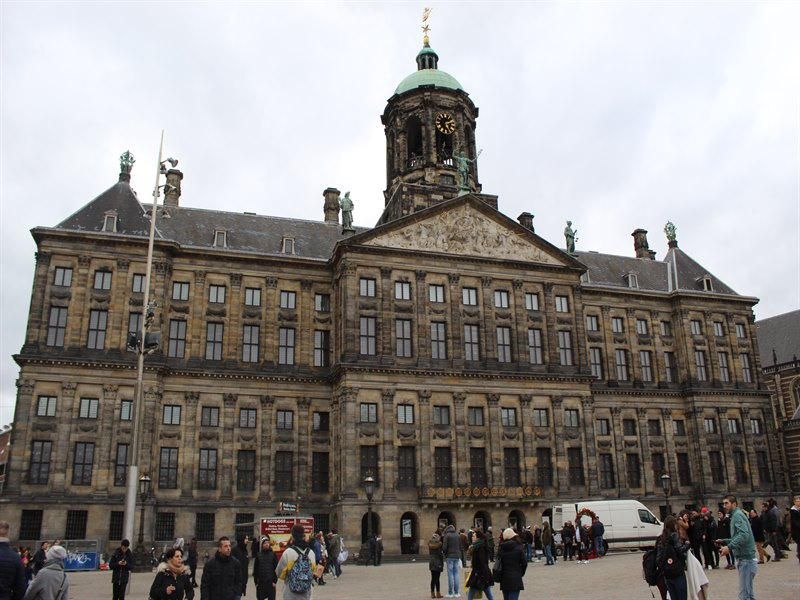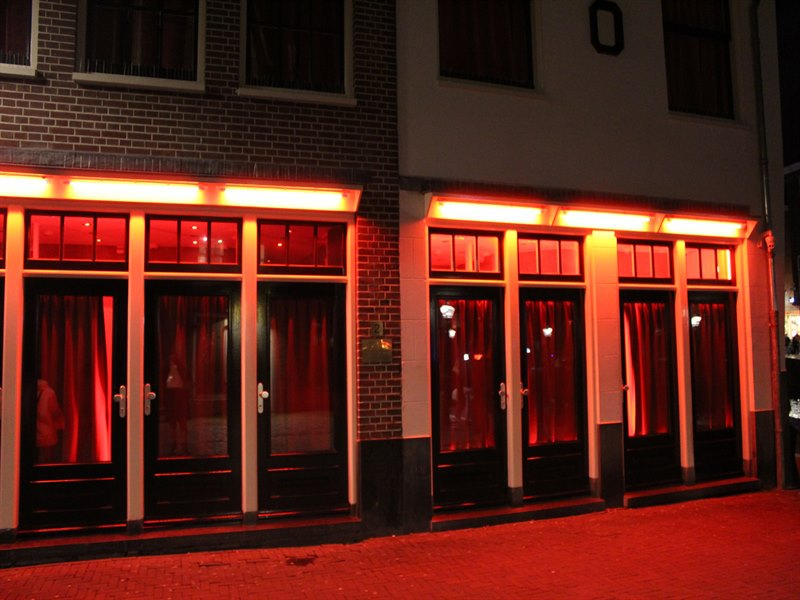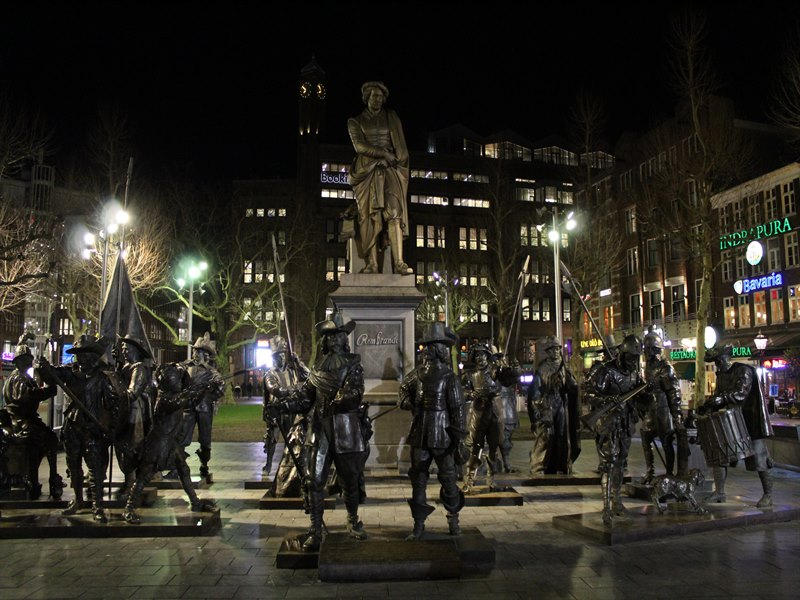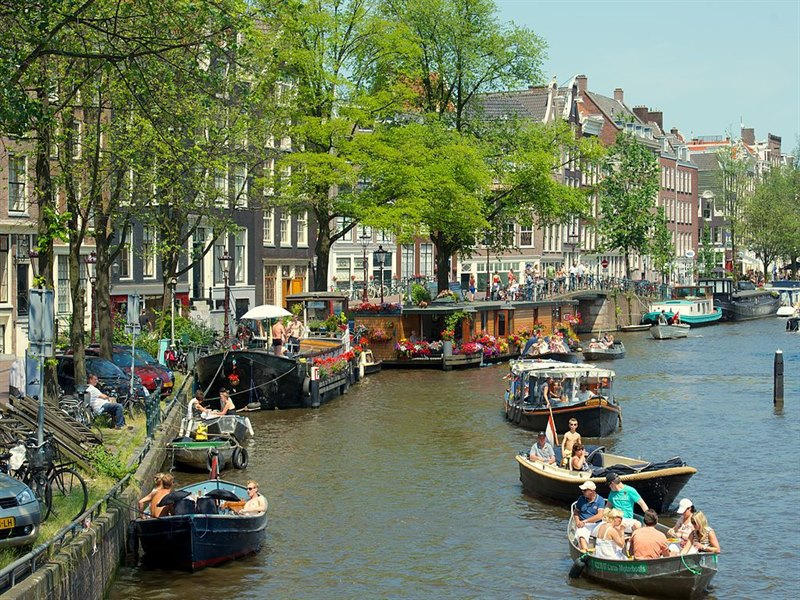When the Dutch refer to Amsterdam, they use the word “Gezellig", which does not translate into other languages. Think of something like the Greek words “Meraki” or “Philotimo”. If I tried to explain it, I would say something as familiar, friendly, relaxed and generally different

When the Dutch refer to Amsterdam, they use the word “Gezellig", which does not translate into other languages. Think of something like the Greek words “Meraki” or “Philotimo”. If I tried to explain it, I would say something as familiar, friendly, relaxed and generally different But in order to understand what I mean, one must have visited it. To walk on one of the canals of the medieval center. To hear the bells of bicycles, to see merchants unloading colorful flowers at flea markets, to taste the excellent local beers and to see with his own eyes why Amsterdam has the nickname "the sin city".
A few words about the city
Amsterdam is the capital and the largest municipality in the Netherlands. Although the capital of the country, it is neither the capital of the province to which it belongs, namely North Holland, (the capital of which is Haarlem), nor the seat of government (which is The Hague). It was founded in the late 12th century as a small fishing village on the banks of the river Amstel, from where it adopted its name. Today it is the economic and cultural center of the country, with a population of 790.044 residents in the city and 2.289.762 in the wider metropolitan area. It is located in the northern part of the wider Radstad region (Randstad), thus constituting one of the largest metropolitan areas in Europe! The city is known for many excellent museums and art spaces, but what makes it so attractive to tourists and gives it the nickname sin, is the part of the city with the "red lights", the de Vallen, and the numerous 'coffee shops'. In Amsterdam, therefore, light drugs such as marijuana and hashish are not illegal, while prostitution is legal, which ranks Amsterdam among the most popular destinations worldwide. So I have chosen for you, what I consider to be worthy of attention for someone who is visiting the city for the first time.
Dam
Dam Square is the most central square of the town and along with the famous buildings that surround it is one of the most famous sights of Amsterdam. The name of the square in Dutch means dam and this was exactly the function of the square at the time of its creation. It was constructed about 1270 and was the first union of the two parts of the Amstel River. Then, as the dam grew, it was joined by an adjacent square and became the commercial and political heart of the city after the creation of the town hall on the square.
In Dam today dominates the impressive royal palace and former town hall (Koninklijk Paleis). It was built between 1648 and 1665 and was the most important historical and cultural building of the Golden Century, even belonging to the 100 Most Important Cultural Heritage ites of Amsterdam. It is a living building, with a turbulent history, where you can follow in the footsteps of royal visitors through its imposing rooms and halls. Admission costs 10e.
Right next door is the New Church (Neuwe Kerk). It is a gothic church of the 15th century, formerly used as a place of secular ritual for royal coronations, while today it is no longer used as a temple, but often for important art exhibitions.
Finally, there you will also find Madame Tussaud's wax museum (admission costs 18e), the historic department store De Bijenkorf, the former Central Post Office (Magna Plaza) and an impressive obelisk dedicated to the victims of the Second World War.

The museums
You may not know it but Amsterdam comes first in the proportion of museums in the world, as it has over 60! So these very interesting museums are one of the main attractions for tourists, as they attract many thousands of people every year.
The National Museum of the Netherlands (Rijksmuseum) is the most important in the country and the one with the most visitors, as it attracts over one million visitors a year! It is a landmark of Amsterdam, opened in 1885 and includes the best paintings representing Dutch painting, including works by Frans Hulls, Vermeer and Rembrandt. Admission costs 19e.
In the Museum Square (Museumplein) you will find another very important Museum of Amsterdam, the one dedicated to the Dutch painter Van Gogh (Van Gogh Museum). Indoors you will admire 200 paintings and 550 sketches, showing all the mental moods of Van Gogh. These are combined with the hundreds of letters of the talented painter to Theo, and the collectible works of his friends and contemporaries, from the core of the museum's collection. Admission costs 19e, but it's usually sold out, so make sure to book your tickets online.
Right next door is the most interesting, for me, museum of the city, the Moco Museum. It is the most recent museum in Amsterdam, having opened its gates only in 2016, aiming to bring forth exhibitions with protagonists and pioneers of the world of Contemporary Art. It began with a temporary exhibition of the famous Banksy (Laugh Now), which, however, became permanent due to the enormous response from the people. Today, the admittedly small mansion hosts exhibitions of other street artists besides Banksky, such as Beanfield and Van SWAT. Admission costs 14.5e.
The house of Anne Frank (Anne Frank Huis) in the center of Amsterdam is one of the most emotionally charged buildings in the city. This is the hidden area where Anne Frank hid for two years from the Nazis and wrote her famous diary, during the Second World War. The original diary is placed as part of the permanent exhibits and is presented in a glass case. Tickets are only sold online and usually run out months in advance, so if you want to visit it you should have it in mind. Admission costs 10e, and a free audio tour is available.
The Museum of the city of Amsterdam (Amsterdam Museum) was founded in 1975 and was called until 2011 Museum of history of Amsterdam. It is a museum that presents how a small settlement along the Amstel river, became in the seventeenth century the center of World Trade and is today a colorful metropolis with highly competitive economy and ideal living conditions for its inhabitants. The museum deals particularly with the canals of the city, as well as with the city's efforts to avoid the three evils of its fate (floods, fire and pestilence), and comes down to contemporary problems, such as how the Dutch replaced traffic and pollution by cars and made Amsterdam the world capital of cycling. Admission costs 15e.
Finally, it seems mandatory to stop at the Sex Museum, which presents the story of how prostitution began in the Netherlands, through interactive rooms, "sly" exhibits and nude photos, which are only sure to cause a lot of comments between you. The entrance costs only 5e.
Amstel & Kanalen
Amsterdam in Dutch means the dam of the Amstel River, as the city is built upon the river. The famous Amstel beer has taken its name from the river, as the breweries were in close proximity and once used water from the river. On the banks of the river are many significant buildings, such as the concert hall "Stopera" and the Opera House "Carre theatre". The Amstel River has many bridges, Blauwbrug, Hoge Sluis and Berlagebrug. The most notable arch of the river is by far the Magere Brug or as the locals call it the “skinny bridge”, which starred in the James Bond film "Diamonds Are Forever". The present bridge was established in 1934 and replaced an identical bridge that had been at the point since 1691 and because of its narrowness, the residents called it skinny. Since 2003 the bridge has been used only by pedestrians or bicycles, symbolizing the city's new transport model.
One of Amsterdam's nicknames is "Venice of the North" and this is not unfair, considering that in the metropolis there are more than a hundred kilometers of canals that cut the city into over 90 islands, connected by over 1500 bridges! The four central canals (Singel, Herengracht, Prinsengracht, Keizersgracht) were dug in the 17th century in the Golden Age of the Dutch empire, while forming concentric zones around the city. Without a doubt, Amsterdam's canals are also the city's signature and a stroll through them offers an alternative view, with over 1550 preserved historic houses or monuments. So in order for your visit to the Dutch capital to be complete, you should take a cruise between the canals. The boats pass through all the noteworthy buildings of the city, and there is usually a recorded guide in English, German and French. The various companies that offer boat rides provide from simple browsers to dinner or lunch on a boat.
Vondelpark
A few minutes from the centre of Amsterdam you will come across Vondelpark. It is an oasis of green, which receives about 10 million visitors annually and opened in 1865, with the original name "New Park", and later took its current name in honor of the 17th century author "Joost van den Vondel", whose statue you will find in the park. If you are in the city in summer and the weather allows it, do not miss the opportunity and live for one day as Dutch. Get all the necessary ingredients from a super market and go for a picnic. You will see thousands of Amsterdamers enjoying the sun and the good weather which in these parts is a rare occurrence. In the park you will also find a film museum, an open theater and several cafes-restaurants.
Red light district- Coffee Shops
Despite the city's wealth in art and culture, Amsterdam has the nickname "Sin City", as in the Dutch capital both prostitution and light drugs are legal. Whether you agree or disagree with them, they are the biggest tourist attraction.
In the area with the red houses (Red light district) you will see heavily painted and dressed girls, attract customers from the windows of their rooms at street level. It is estimated that there are about 300 windows illuminated in red, offering services all day. Crowds of people pass through the alleys to gaze, but you must know that taking pictures is prohibited and severely punished. Therefore if you don't want to see your phone or camera at the bottom of a canal, you should be extra careful. However, if you can get over the prostitution part and focus on the rest, this area is truly one of the prettiest and most ancient parts of the canal ring, which revolves around Amsterdam's oldest church (Oude Kerk).
Amsterdam's Coffee Shops are an experience you undoubtedly have to experience. There are about 150 of them scattered in the city, you will not have any difficulty in finding one. Usually, it's just coffee where you're just allowed to consume light drugs, like marijuana, but you can of course just drink a coffee. After the prohibition of cigarettes indoors in shops that do not occupy enough space to make a special room, there is the following paradox: you are allowed to smoke marijuana as long as there is no smoke inside!

Zuiderkerk -Westerkerk
In addition to the New Church (Neuwe Kerk) in Dam Square and the Old Church (Oude Kerk) in the Red Light District, there are two other temples worth visiting.
The first is the Southern Church (Zuiderkerk), a 17th-century Protestant church in the Nieuwmarkt district that played an important role in Rembrandt's life and was painted by Claude Monet. It was built from 1603 to 1611 and was the first church in the city built specifically for Protestant services. The church is open to the public and today functions as a municipal information center with exhibitions on housing and the environment, and since 2006 also houses the "Wall of Fame", a tribute to Dutch "celebrities" who have made a positive contribution to society, such as charity work.
The second is the Western Church (Westerkerk), also Protestant, located in the center of Amsterdam right next to the Anne Frank House and between the Prinsengracht and Keizersgracht canals. It was erected between 1620 and 1631 in Renaissance style according to the designs of the architect Hendrick de Keysero, who also designed the Zuiderkerk. It is the largest Protestant church in the Netherlands and still functions as a church.
Rembrandtplein
The Rembrandt Square (Rembrandtplein) was, of course, named after the famous Dutch painter, whose house was right there and now functions as a museum. The square is connected to the nightlife of Amsterdam, as there you will find many clubs, bars and coffee shops, as well as hotels, restaurants, cafes and various shops of all kinds. In the center of the square is the imposing statue of Rembrandt, which since 2006 has been accompanied by several more bronze statuettes. These were designed by the Russians Mikhail Dronov and Alexander Taratynov, as part of the celebration of the 400 years of the artist, representing the painter's most famous painting, "The Night Watch".

Albert Cuyp Market-Bloemenmarkt
The Albert Cuyp flea market is undoubtedly the most famous and busiest foreign market in Europe! It has over three hundred counters with a huge variety of products of all categories, from local delicacies and fresh fruit, to clothes and shoes. It attracts thousands of tourists every day, especially on Saturdays, thus playing a very important role in the economy and daily life of the Dutch capital. The market is located in the Pijp area and is surrounded by pleasant cafes and small shops.
Of course, since you are in the country of flowers and more specifically in the homeland of the tulip, you should take a walk through the homonymous open market (Bloemenmarkt). It was founded in 1862 and spreads parallel to the Singel canal in the center of Amsterdam. There you will find seeds and bulbs to buy from the national flowers of the Netherlands, as well as garden decorations and souvenirs.
Jordaan
For many people, the Jordaan region is one of Amsterdam's most pleasant areas of the city. In the past, it was highly degraded and only people of the so-called working class and immigrants lived there. Today, however, the scene has changed dramatically, since the former "slum" has been renovated and is now inhabited by a lively mix of students, well-off entrepreneurs and creative professionals. Jordaan is a beautiful-atmospheric area, with narrow streets, picturesque canals, alternative cafes, art galleries and unique shops. You can easily get lost in a pleasant walk through the charming streets connecting the 4 main canals.

Heineken Experience
Last but certainly not least, I left an activity, which I strongly recommend to all beer lovers. This is the Heineken Beer Visitor Center, housed in a historic brewery, the first to produce Heineken beer. The brewery was the main area for the production of beer until 1867, when it was replaced by a newer, modern area in the suburbs of the city. In 1991 the brewery opened its gates as a Public Information Center and after its fantastic commercial success was upgraded in 2001, while in its current form it operates after its renovation in 2008. It consists of four levels, historical artifacts, product exploration, sampling and interactive exhibits on the technology of modern beer production. With the ticket that costs 18e, you will have the opportunity to sample three beers of the homonymous brewery, completely fresh since they are maximum three days old. Finally, you can print a bottle of Heineken with your name, engrave something on a glass and buy dozens of souvenirs of all kinds from the gift shop on the ground floor.
How to go
Thessaloniki is connected by air to Amsterdam and Schiphol Airport via Transavia. With proper planning one can find tickets starting from 106€ round trip! Beyond that, if you want something more economical, you can choose a combination Ryanair flight, with a stopover to Eindhoven, which is about an hour and a half by train from Amsterdam and tickets can be booked from 51€ round trip!
Where to stay
Amsterdam is a highly touristic city all year round, which implies a lot of accommodation, but it is very expensive compared to what they offer. I would suggest you avoid the centre, where prices are exorbitant and look for something a little further out. So my suggestion is Hotel de Munck, a 2 star hotel, with spacious rooms and helpful staff, located next to the "skinny bridge", just 20 minutes from Dam Square on foot.
How to move
In Amsterdam the bikes are more than the people themselves and so both locals and tourists mainly choose this means of transportation, since the roads are well adapted for cyclists and everyone has the appropriate cycling education. Renting a bike is very simple, since there are shops all over the city that rent bicycles, and there are specially designed places; where by simply downloading an app on your mobile you will have solved, with 3 to 5 euros per day, your transportation problem. However, if the weather does not allow or you are not so enthusiastic about the idea of cycling, in the town there is also metro with several lines, buses with several routes, as well as trams that are very handy and cover a large part of the city. Finally, as far as taxis you can find them either on the road or call them by phone, but they are expensive and are little used.
What to eat
Dutch cuisine is not something special and as a country the Netherlands is not famous for specific products, with the exception of course of cheeses (see Gouda) and potatoes. This means that locals mostly choose foreign cuisines, let alone Amsterdam which is an extremely multicultural city.
If you want to get an insight into this multiculturalism, I suggest you visit Foodhallen, a hall with several shops offering flavors from all over the world. Feel free to try Indonesian and Vietnamese cuisine, which I consider to be the most delicious.
Beyond that, for meat I recommend Cannibale Royale, which is the most popular in Amsterdam, having four restaurants in the urban area. Due to high demand, it's usually full, so make a reservation. Try the pork chops with the barbecue sauce, a trademark dish of the shop.
For Italian cuisine I recommend La Perla and for Chinese the New Season, which although it is located in the most touristic part of the city is high quality.
Finally, for breakfast or brunch I would say visit Plunk, which is a representative sample of the city's culture and for coffee the impressive Grasshoper overlooking the canals of Amsterdam.
Useful information

In Amsterdam we travel with a passport or a new type of Police ID, where the details are indicated in Latin characters.
In Amsterdam the language used is Dutch. The majority though, if not all, speak English (and German), so ask for clarification in English.
The currency of the country is the euro.
Amsterdam is an hour behind Greece (GMT +2).
Getting to and from Amsterdam airport is simple, since there is a train that will take you to the Central Station of the city in about 20 minutes, with just 5.5e.
The Greek Embassy in the Netherlands is located in Hague and more specifically at 1 Amaliastraat Street and its phone is +3170 3638700.
Book all your museum tickets and activities online, as most of them are sold out directly, due to high demand and so you may find yourself surprised.
You should know that in the Netherlands light drugs, such as cannabis and marijuana, as well as prostitution are legal, which means that you will find them everywhere in the city.
The best time to visit the city is the end of spring and the beginning of summer or autumn. Due to the many canals and the Amstel River, there is enough moisture and the weather is often rainy, which will make your life difficult since the city is suitable for walking and cyclists.
Recommended excursions → Rotterdam, Utrecht, Hague

If this article seemed interesting or contributed to your quality information, then you can like my facebook page: o_thessalonikios or follow me on instagram!
Mouzakidis Pantelis









